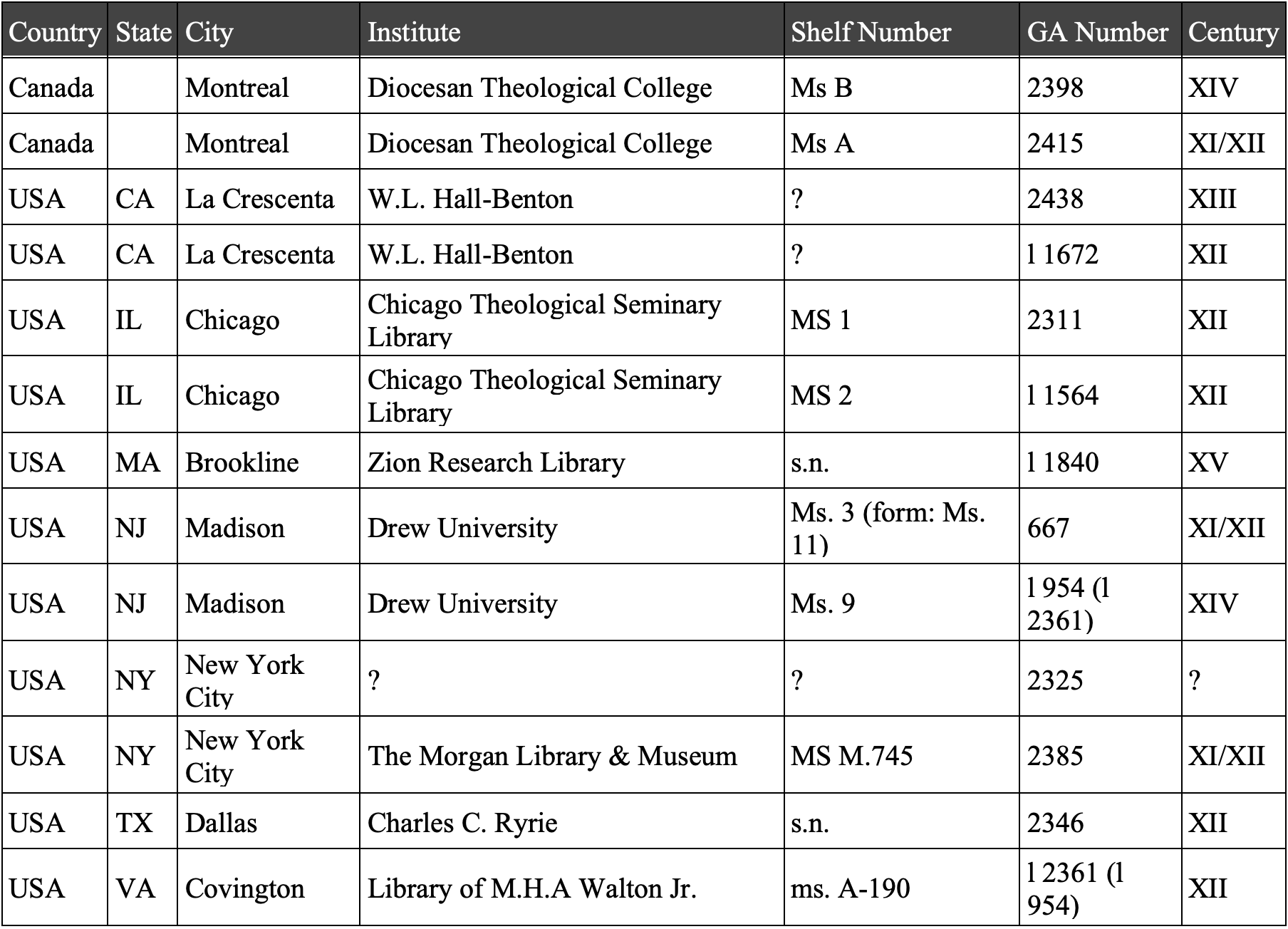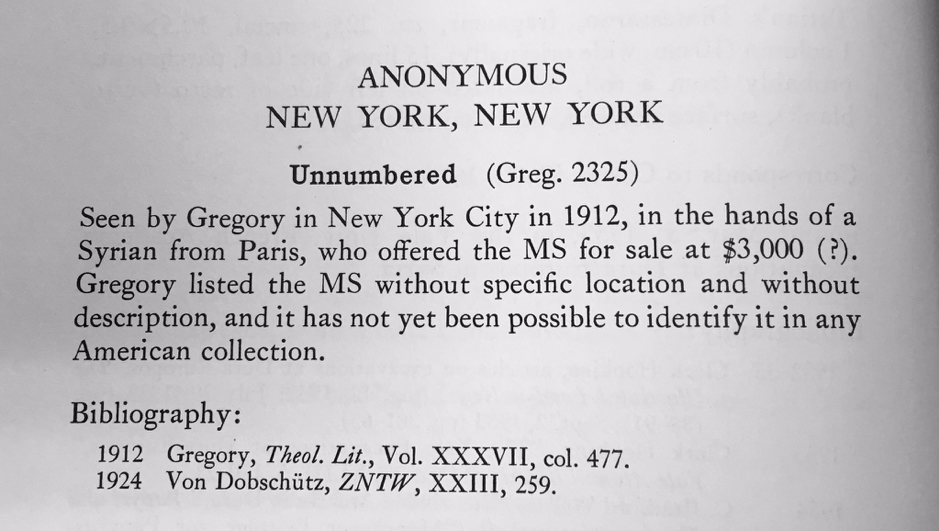By: Jacob W. Peterson
Yesterday, CSNTM posted on social media: “Did you know 13 Greek New Testament manuscripts formerly known to be in the US or Canada are now lost or missing?” We intended this to just be an interesting factoid that particularized an unfortunately all too common problem resulting from accidental loss, destruction, and items being sold into private collections. However, we got quite a response asking for additional details, so I wanted to take the time to provide a bit of context.
Naturally, terms like “missing” and “lost” can have a certain definitiveness that may not be appropriate in every instance. A couple of the manuscripts in the thirteen count are legitimately lost, in the sense that there is no paper trail or leads as to their location (see the description of the manuscripts in Montreal below). Others among the thirteen are merely unaccounted for at present (i.e. “missing”). Typically, these are manuscripts that have been sold anonymously through an auction house, meaning we know someone currently possesses them. So, they are not irretrievably lost, but rather have been moved to an unknown location and are thus currently unavailable for scholarly research. Of course, the hope is that these do eventually turn back up (and they often do, as the case with some of the Charles C. Ryrie manuscripts).
A project we’ve been working on recently at CSNTM has been to determine the state of digitization of Greek New Testament manuscripts in North America. It only makes sense for us to be aware of what is going on in our own backyard! There are numerous manuscripts that have been divided between multiple libraries such that there are around 360 distinct shelf numbers related to Greek New Testaments in North American collections. I’m happy to report that in addition to the work that CSNTM has done, many libraries and museums have undertaken their own digitization projects so that around 80% of them have already been digitized. We’ll hopefully say more about this in the future.
Gaining an accurate picture of things necessitated tracking down as many of the North American manuscripts listed in the online Kurzgefasste Liste as possible. The researchers at INTF have already commented on the state of most of these manuscripts, lest anyone believe this is all my own original labor. Accordingly, the list could grow as we continue the project, but the thirteen manuscripts currently believed to be “lost” or “missing” are:

So, what happened? In most cases the collections appear to have been dissolved, which more often than not means sold at auction or dispersed to heirs. This was the case with collection of Charles C. Ryrie, who owned a few Greek New Testament manuscripts that were sold at Sotheby’s in 2016. One of his manuscripts went to Dumbarton Oaks (GA 669), and another went to the Museum of the Bible (GA 2813). Unfortunately, the new owner of GA 2346 is currently unknown. The same is true of MS 1 (and likely MS 2) from the Chicago Theological Seminary Library.
The Liste entries for MSS 3 and 9 from Drew University include identical notes that, according to Dr. Kavrus-Hoffmann, each manuscript “has been missing since the early 1930s, when it was studied by Everett Arthur Overton for his dissertation ‘The ‘Drew’ Gospel Manuscripts’ One can surmise that this manuscript was borrowed by Overton and never returned to the library and its present location is not known.” MS 9 from Drew ends up being doubly lost, in a sense. It appears that it eventually made its way into the collection of M.H.A Walton, where it was re-catalogued as lect 2361. Unfortunately, as can be seen in the above chart, the Liste records that the Walton manuscript collection was dispersed in 2009 and its current location is unknown.
About the manuscripts from the Diocesan Theological College, the Liste states they “must now be considered irretrievably lost. The College library no longer exists and [the leaves have] not been located among the material transferred to the McGill Library.”
In the case of GA 2325, for which we only know New York City as a location, the manuscript likely should have never been catalogued to begin with. The manuscript is almost comically described as follows in Kenneth W. Clark, A Descriptive Catalogue of Greek New Testament Manuscripts in America (Chicago: University of Chicago Press, 1937), 376.

The cited bibliography contains no additional details about the manuscript or its owner.
It is basically incorrect to state that “GA 2385” from the Morgan Library & Museum is “missing” or “lost.” Rather, the manuscript is a palimpsest and part of its undertext was incorrectly identified as from the New Testament and was given a Gregory-Aland number. As it turns out, the undertext is entirely from the Septuagint (see, Nadezhda Kavrus-Hoffmann, “Catalogue of Greek Medieval and Renaissance Manuscripts in the Collections of the United States of America. Part IV,2: The Morgan Library and Museum,” Manuscripta, 52, 2008, p. 276 n. 87. h/t INTF Liste).
Finally, I can briefly talk about the availability of images of these thirteen manuscripts. Unfortunately, I have been unable to find images of the Diocesan Theological College leaves of 2398 or 2415. Similarly, images of 667, 2325, 2438, lect 1564, lect 1672, and lect 1840 have not been found. Fortunately, not all is lost. In its earliest years, CSNTM digitized 2346 when it was in the collection of Dr. Ryrie. Microfilm images also exist of 2311 and Lect 954/2361. Additionally, microfilms do exist of “2385,” but again it is a Septuagint manuscript. The last three of these are all available through the NT.VMR.
Thank you all for your interest in this discussion as expressed on social media. If any of you happen to have information on the whereabouts of any of these lost or missing manuscripts, we would be most grateful.

